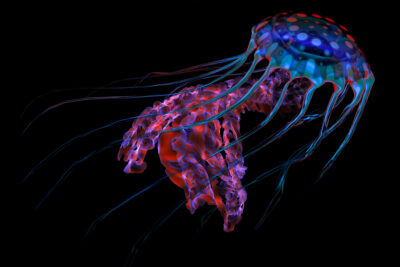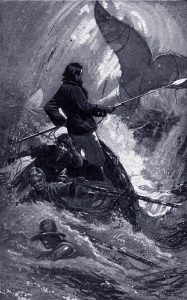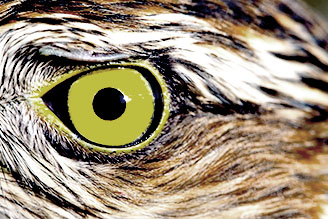by Richard William Nelson | Feb 9, 2017
 Bioluminescence (pictured left) has fueled folklore legends for thousands of years. From the eighth-century Japanese Hotaru firefly legend to the Apache Indian firefly origin of fire celebration, the origin of bioluminescence continues to inspire awe and wonder.
Bioluminescence (pictured left) has fueled folklore legends for thousands of years. From the eighth-century Japanese Hotaru firefly legend to the Apache Indian firefly origin of fire celebration, the origin of bioluminescence continues to inspire awe and wonder.
Describing myths and legends with a natural explanation is what drives scientists. “Researchers have long wondered how bioluminescence came to be,” science writer Steph Yin noted in the article “In the Deep, Clues to How Life Makes Light,” published in Quanta Magazine.
Continue Reading
by Richard William Nelson | Dec 29, 2016
 To think that shape affects function – or form follows function – is an implicit assertion used ubiquitously throughout the evolution industry. This assumption, however, is untested. As an evolutionary biologist, Fouad El Baidouri (pictured right below) of the University of Lincoln, UK, explains –
To think that shape affects function – or form follows function – is an implicit assertion used ubiquitously throughout the evolution industry. This assumption, however, is untested. As an evolutionary biologist, Fouad El Baidouri (pictured right below) of the University of Lincoln, UK, explains –
“Despite a few pioneering attempts to link bacterial form and function, functional morphology is largely unstudied in prokaryotes [microbes].”
Continue Reading
by Richard William Nelson | Nov 17, 2016
 Early northeast colonial settlers, William Bradford and Edward Winslow, in 1620 sent out a business prospectus: “Cape Cod was like to be a place of good fishing, for we saw daily great whales, of the best kind for oil and bone.”
Early northeast colonial settlers, William Bradford and Edward Winslow, in 1620 sent out a business prospectus: “Cape Cod was like to be a place of good fishing, for we saw daily great whales, of the best kind for oil and bone.”
The American whaling industry was beginning. Two hundred years later, New England was the premier whaling center in the world. More than 10,000 men set sail on whaling ships in 1857 from New Bedford, Massachusetts, alone. Indeed, the evolution or extinction of whales was not a popular topic.
Within the next 100 years, during the lifetime of Herman Melville’s mythical Moby Dick (illustrated), the whaling industry was forced to hunt deeper into the ocean and eventually into the southern Atlantic, leaving the North Atlantic population decimated.
Continue Reading
by Richard William Nelson | Aug 25, 2016
 The mystery behind the superiority of bird eyesight over humans is now more mysterious than ever. Joe Corbo, staring into the eye of a chicken seven years ago, saw something startling carpeting the retina. Rather than randomly distributed color-sensitive cones, like in humans, Corbo observed a uniform distribution of the cones – a pattern previously unrecognized in birds.
The mystery behind the superiority of bird eyesight over humans is now more mysterious than ever. Joe Corbo, staring into the eye of a chicken seven years ago, saw something startling carpeting the retina. Rather than randomly distributed color-sensitive cones, like in humans, Corbo observed a uniform distribution of the cones – a pattern previously unrecognized in birds.
Science writer Natalie Wolchover (pictured right below), in A Bird’s-Eye View of Nature’s Hidden Order published in Quanta Magazine in July, reported that while cones were remarkably uniform in distribution, the actual cone locations seemed haphazard. “The dots’ locations followed no discernible rule, yet never seemed too close or too far apart” – a strange mix of bird-eye random regularity.
Continue Reading
by Richard William Nelson | Jul 28, 2016
 In the native land of Charles Darwin, for the first time, the Royal Society is challenging evolutionary academia to develop a new theory of biological evolution. As the original science organization in Western Civilization, the Society explains the problem with today’s most popular current theory:
In the native land of Charles Darwin, for the first time, the Royal Society is challenging evolutionary academia to develop a new theory of biological evolution. As the original science organization in Western Civilization, the Society explains the problem with today’s most popular current theory:
“Developments in evolutionary biology and adjacent fields have produced calls for revision of the standard theory of evolution, although the issues involved remain hotly contested.”
Increasingly, the standard theory of evolution has been challenged in the wake of the twentieth-century genomic revolution.
Continue Reading
 Bioluminescence (pictured left) has fueled folklore legends for thousands of years. From the eighth-century Japanese Hotaru firefly legend to the Apache Indian firefly origin of fire celebration, the origin of bioluminescence continues to inspire awe and wonder.
Bioluminescence (pictured left) has fueled folklore legends for thousands of years. From the eighth-century Japanese Hotaru firefly legend to the Apache Indian firefly origin of fire celebration, the origin of bioluminescence continues to inspire awe and wonder.
 To think that shape affects function – or form follows function – is an implicit assertion used ubiquitously throughout the evolution industry. This assumption, however, is untested. As an evolutionary biologist,
To think that shape affects function – or form follows function – is an implicit assertion used ubiquitously throughout the evolution industry. This assumption, however, is untested. As an evolutionary biologist, 
 The mystery behind the superiority of bird eyesight over humans is now more mysterious than ever.
The mystery behind the superiority of bird eyesight over humans is now more mysterious than ever.  In the native land of
In the native land of 